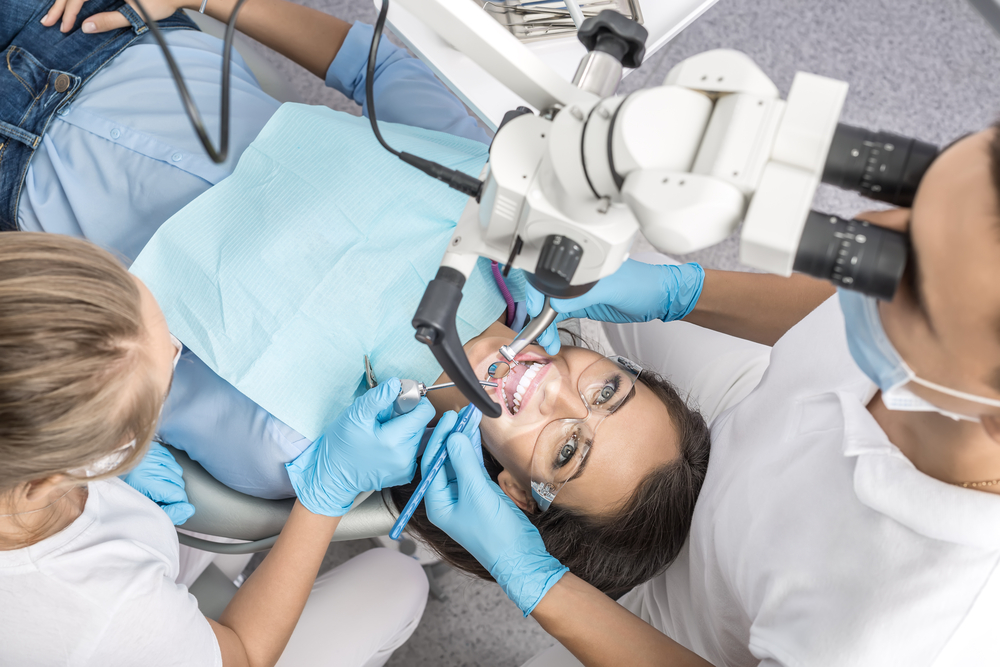
The pulp is a tissue that contains vessels and nerves that fill the chamber and canals of a tooth. Pulp contamination occurs mainly through carious lesions, which allow bacteria to penetrate into its interior, but also through exposed dentinal tubules in cavities of non-carious origin or as a result of their exposure during an injury. The pulp disease may, by continuity, spread to the periodontium and alveolar bone, which in advanced cases may appear as a cyst or an abscess.
An indication for endodontic treatment is irreversible pulpitis, which in turn leads to pulp necrosis. The patient may come to the office with a severe toothache or may not report any symptoms, and then, the disease process is detected accidentally by means of a cold thermal stimulus test or a visible pathology on the X-ray. Root canal treatment allows for the removal of diseased tissue and the preservation of the tooth, which the patient can enjoy for many years to come. Endodontic procedures may also be required in teeth on which prosthetic work is planned, such as crowns and bridges due to their excessive destruction, extensive fillings or significant protrusion out of the occlusal plane.
The number of visits for the root canal treatment depends on the possible complications that the doctor may encounter during the procedure (obliterated or calcified canals, additional canals or significantly curved canals). Sometimes the treatment can be completed in one visit, and on other occasions, it may require long hours and numerous meetings. An X-ray is needed for full diagnostics, and more often doctors require a computed tomography of a single tooth, which most accurately depicts a given case.
Root canal treatment involves the removal of bacterially infected tissue from the pulp chamber and the root canals. We distinguish two main stages: the preparation of the canals and their obturation. The preparation of the canals consists of manual and mechanical removal of the tissue, forming the proper shape and abundantly rinsing with antiseptic agents. To make sure that the infected tissue has been removed along the entire length of the root canal, its length is measured using a device called an apex locator. After the proper cleaning of the inside of the tooth, it should be tightly closed to prevent the bacteria from re-entering the tooth. The currently used material for filling root canals is gutta-percha in the form of cones or heated up to the appropriate temperature in semi-liquid form. The whole root canal treatment is carried out under a protective rubber barrier, i.e. a rubber dam that isolates the tooth from saliva and protects the patient against aspiration or ingestion of small endodontic instruments or rinsing agents.
The proper progress of healing after the treatment is controlled with digital X-rays. The filling material is visible in the form of a "white ribbon" that reaches the root apices.
After finishing the root canal treatment, the temporary filling placed in the tooth crown should be replaced with a permanent restoration. If the crown of the tooth is not too damaged, a composite filling can be used, however, with greater damage, it is necessary to rebuild the tooth with inlays, onlays or a crown with root posts (see the prosthetics reference). Do not wait too long to rebuild the tooth permanently, because there is a risk of fracturing the weakened tooth walls.
Treatment under a microscope
The possibility of proper root canal treatments has increased due to the huge progress in endodontics in the field of devices, instruments and materials. One of the biggest innovations is the introduction of a dental microscope to the daily practice of endodontics, which aims to enlarge the treatment area and the accuracy of its lighting. The doctor uses a microscope to search for the root canal accesses in the pulp chamber, any additional canals, to prepare obliterated canals, to detect and protect against perforations, to remove broken instruments, and to perform repeated root canal treatments. Thanks to the microscope, endodontic treatment has become more secure and the result more predictable. The treatment under magnification reduces the failure rate of root canal treatments and in the near future will become a standard in the field of endodontics.
FAILURE OF ROOT CANAL TREATMENT AND ALTERNATIVE TREATMENTS
Due to the complex morphology of the root canals in a tooth, it is not always possible to properly treat the tooth. In such cases, endodontic surgery may be performed, in order to avoid immediate extraction of the tooth. One of these surgical procedures is the resection of the tooth apex, which is used in the case of non-healing bone lesions a year after a correct root canal treatment has been performed or in the case of the inability to prepare the root canal up to the apex. This treatment is contraindicated in teeth that are toot short, in advanced periodontal disease, in an unfavorable tooth position, and when the inflammatory process encompasses too much of the tooth root. The resection consists of an incision to make a mucoperiosteal flap, bone trepanation in the apical area, removal of the inflammatory tissue around the apex with a sharp instrument, cutting off about 3mm of the apical part of the root, and sealing the root apex with the Pro Root MTA cement. The wound is secured with sutures. Other treatment possibilities are hemisection, which consists of cutting off one root and half of the tooth crown or a radisection in which the tooth root is removed but the entire crown is left intact.
Offer
Warszawa Ochota
Adres:
ul. Dorotowska 9
02-347 Warszawa
Telefon: +48 501 328 772
E-mail: recepcja@ddclinic.pl
Godziny otwarcia:
Poniedziałek - Piątek: 9:00 - 20:00
Sobota: nieczynne
Warszawa Ursynów
Adres:
ul. Migdałowa 10 lok.5
02-796 Warszawa
Telefon: +48 502 070 050
E-mail: recepcjaursynow@ddclinic.pl
Godziny otwarcia:
Poniedziałek - Piątek: 12:00 - 20:00
Sobota: nieczynne

